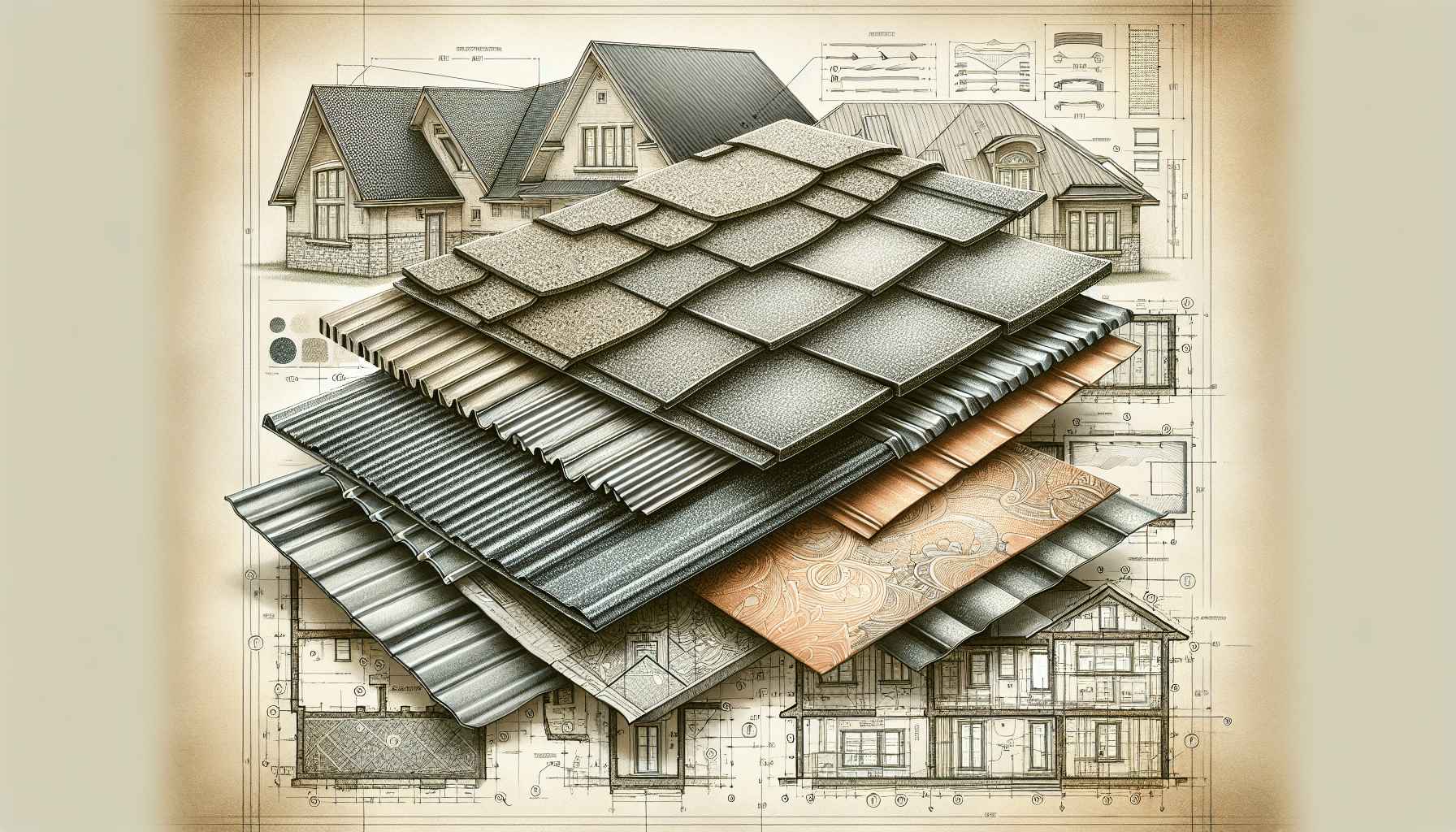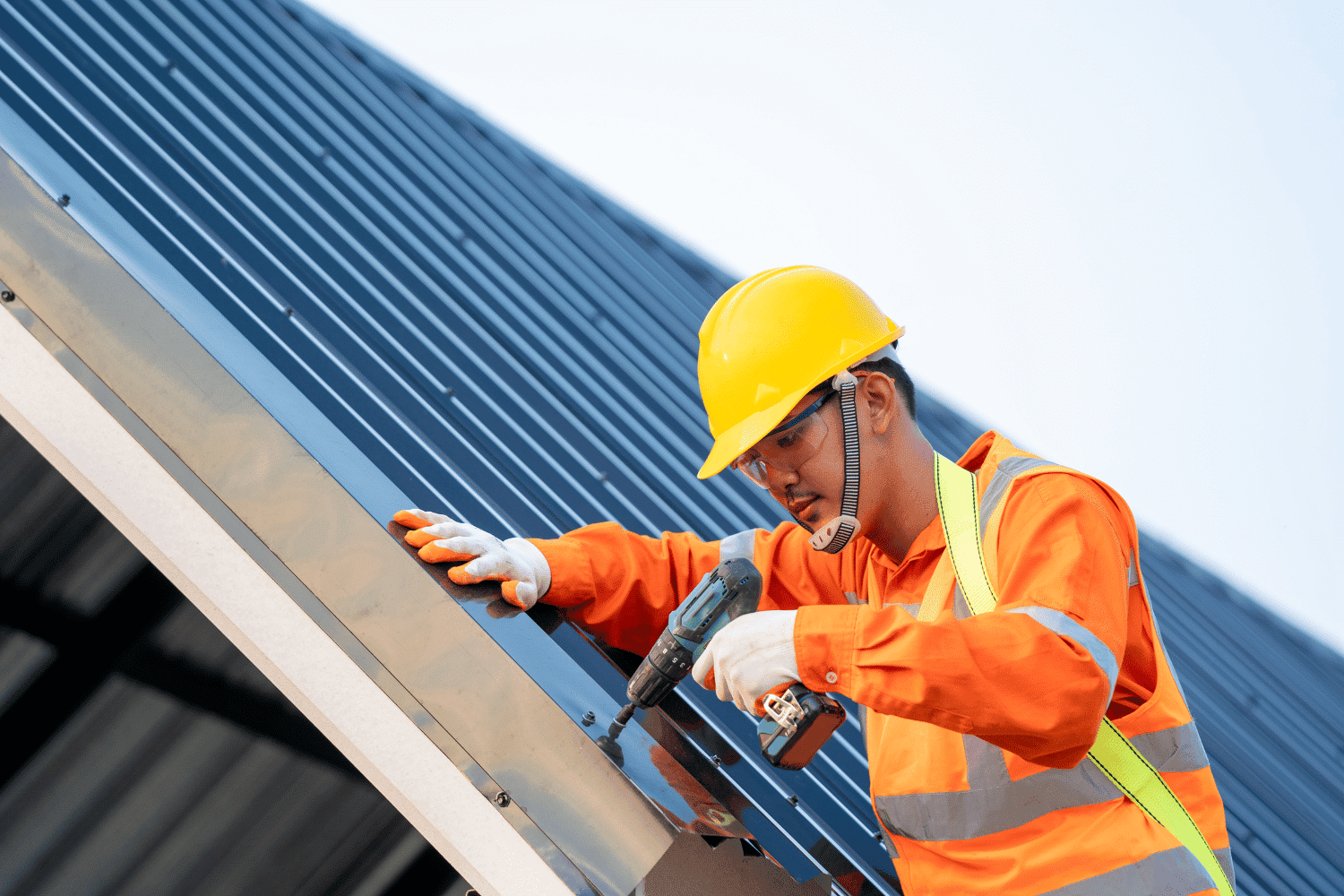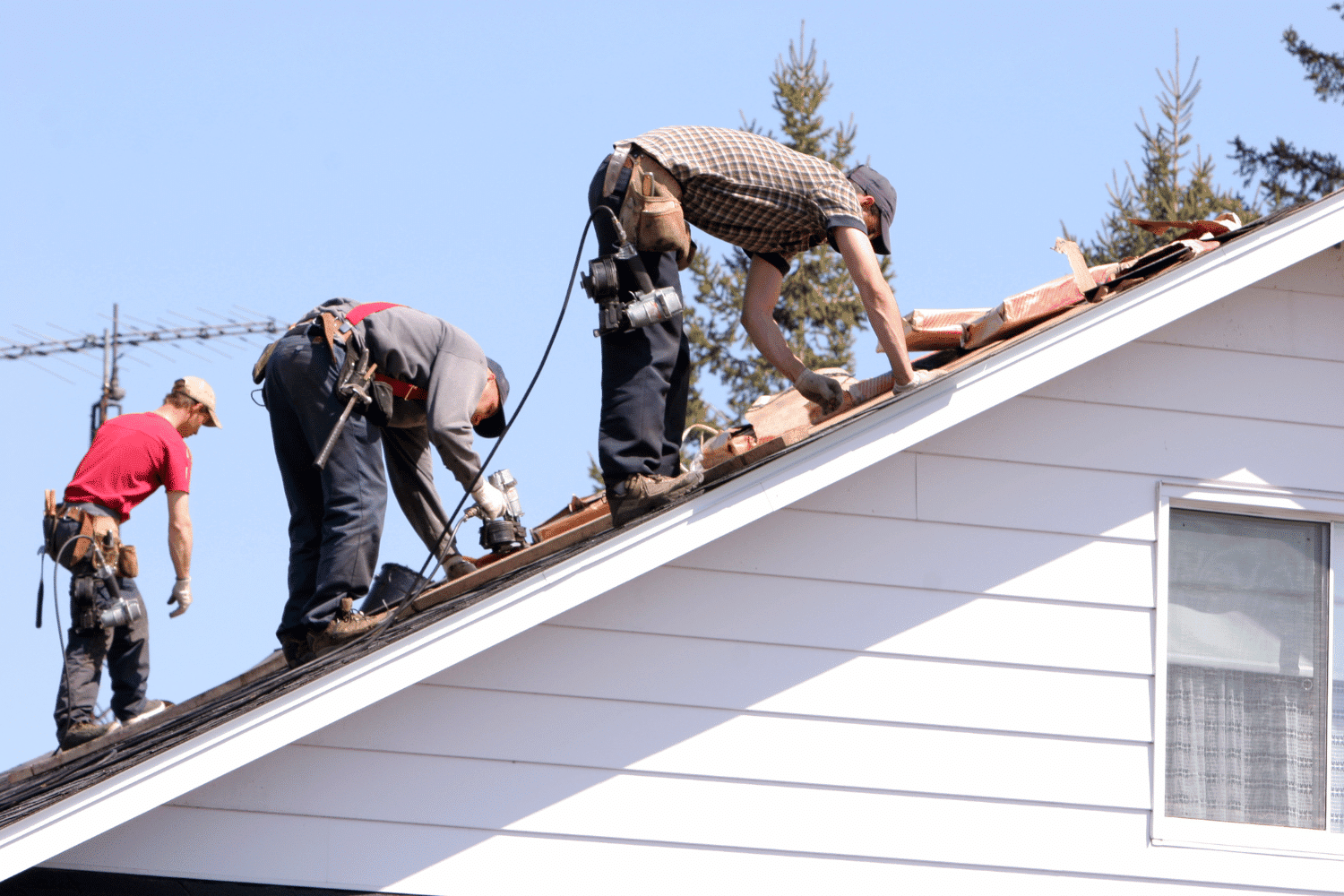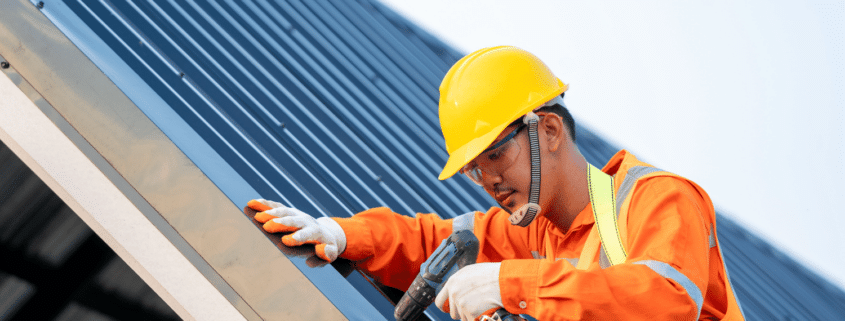Top Tips for Roofing for New Construction
Starting a roofing project for new construction? This guide covers essential tips, materials, challenges, and costs related to roofing for new construction that you need to know.
Key Takeaways
-
New construction roofing requires careful planning and coordination with contractors to ensure compatibility and successful installation.
-
Choosing the right roofing material is essential for durability and aesthetic appeal, with options like asphalt shingles, metal roofing, and slate available for various needs.
-
Hiring professional roofing contractors is crucial to guarantee proper installation, improve safety, and ensure compliance with building codes, ultimately enhancing roof performance and longevity.
Understanding New Construction Roofing

New construction roofing involves the installation of roofing materials on a new building. Unlike roof replacement, which entails removing old materials and installing new ones, new construction roofing is all about starting from scratch. This process includes setting up the roof’s framework, laying down the underlayment, and finally, installing the roof covering.
The importance of new construction roofing cannot be overstated. It ensures that the roof is perfectly compatible with the new building, providing a seamless integration that contributes to the overall structural integrity and durability of the construction. This stage is typically more intricate and can be more expensive than roof replacement due to the complexity of building a roof from the ground up.
New construction roofers carry out various tasks, such as working on the framework, underlayment, and roof covering. Effective coordination with building contractors is critical to ensure the roofing is installed optimally and within the project schedule. This collaboration helps identify and resolve potential issues early, ensuring a smooth workflow and timely completion.
In essence, new construction roofing is a foundational aspect of any new building project, setting the stage for a roof that not only protects but also enhances the building’s aesthetic and functional qualities.
Choosing the Right Roofing Material for Your New Construction

Selecting the right roofing material is crucial for both the longevity and visual appeal of your new construction. With various options available, each with its benefits and drawbacks, making an informed choice will ensure your new roof stands the test of time.
Asphalt shingles are a popular, cost-effective choice known for their versatility and excellent protection against weather elements. On the other hand, metal roofing offers unparalleled durability and energy efficiency, making it suitable for a wide range of new construction projects. Slate roofing, while more expensive, is admired for its beauty and requires minimal maintenance once installed.
Concrete tiles, though capable of lasting up to 50 years, may require more maintenance due to their tendency to absorb water. For those seeking high durability with virtually no maintenance, synthetic composite shingles are an excellent option. Cedar shake roofing provides a premium appeal and is extremely durable, although it comes at a higher price point.
Ultimately, the best roofing material for your new construction will depend on your specific needs, budget, and aesthetic preferences. Consulting with a professional roofing contractor can help you navigate these options and make a decision that aligns with your vision for your new building.
Planning Your New Construction Roofing Project
Proper planning is the cornerstone of a successful new construction roofing project. The process starts with clearly defining the work required, which often involves collaboration between the sales team and estimator to ensure all aspects are covered. Unlike roof replacement, new construction roofing requires a more detailed plan to ensure compatibility with the new building.
Obtaining all necessary permits and ensuring compliance with local building codes is crucial to avoid any project delays. Modern technology, such as drones for site surveying and visualization software for design, can significantly enhance planning efficiency. Creating contingency plans to address unexpected challenges, such as weather-related delays or material shortages, is also essential.
Assigning a dedicated project manager to oversee the roofing project can help keep everything organized and on schedule. This person will coordinate with various teams, ensure all tasks are completed on time, and address any issues that arise promptly.
Common Challenges in New Construction Roofing

New construction roofing projects often encounter several challenges. Common framing issues, such as improperly angled Bird’s Mouth cuts, imprecise rafter lengths, and unsupported roof sheathing, can complicate the process. Effective communication with contractors is vital to identify and address these issues early.
Weather-related delays are another significant challenge, as roofing tasks are highly dependent on suitable weather conditions. Moreover, health and safety hazards, such as leaks leading to mold growth and structural weaknesses, necessitate careful planning and execution to prevent long-term damage.
Residential New Construction Roofing
Residential new construction roofing comes with its unique set of challenges and solutions. There are several common roof types. These include Dutch gable, dormer, intersecting/overlaid hip, and hip and valley. Rapid Roofing installs a variety of materials for residential projects. These materials include traditional asphalt shingles, stone-coated metal shingles, standing seam metal, metal panels, and tile. These materials offer benefits like heat reflection, cost efficiency over time, and recyclability, making them ideal for new homes.
Addressing these challenges requires a thorough understanding of residential roofing dynamics and a commitment to quality and precision. Choosing the right materials and collaborating with experienced roofing contractors ensures homeowners end up with roofs that are both durable and visually appealing.
Commercial New Construction Roofing
Commercial new construction roofing presents its own set of challenges. Common materials used for flat commercial roofs include:
-
PVC
-
TPO
-
EPDM
-
Modified Bitumen
These materials are chosen for their durability and ability to handle the unique demands of commercial property.
Challenges such as drainage issues, improper slope, and inadequate pipe venting are prevalent in commercial roofing projects. Consulting roofing professionals early in the process, preferably once the roof is sheeted, helps avoid these issues. This ensures that the roofing system is designed and installed correctly from the start, preventing costly repairs and replacements down the line.
The New Construction Roofing Process at Rapid Roofing

At Rapid Roofing, the new construction roofing process begins with a detailed inspection of the construction roof once the contract is approved and signed. During this initial inspection, the planned roof type and system, including the deck, insulation, and covering, are analyzed to ensure everything is in order.
Great communication and expertise ensure the roofing work proceeds smoothly throughout the process. Once the installation is complete, a final inspection is carried out to verify that all roofing system requirements have been met.
This thorough approach ensures that each roofing project is completed without issues, providing clients with a reliable and long-lasting roof.
Cost Considerations for New Construction Roofing
The cost of new construction roofing is generally higher than roof replacement due to the intricate work involved in building a roof from scratch. Several factors influence the cost, including the choice of roofing material, the complexity and size of the roof, and regional labor rates. For instance, roofs with steeper pitches may incur higher labor costs due to increased safety measures required for installation.
Long-term value should also be considered when selecting materials, as higher-quality options may reduce future maintenance costs. Additional features such as skylights or gutters can complicate the installation and raise costs, so it’s essential to budget for these elements. Obtaining multiple quotes from contractors can help in comparing prices and securing the best deal.
It’s also advisable to budget for unexpected expenses during the project to manage potential cost overruns, and exploring financing options can be beneficial if the project costs exceed initial budget constraints.
Why Hire Professional Roofing Contractors for New Construction
Hiring experienced professionals for new construction roofing is crucial, as proper installation significantly impacts the roof’s performance and longevity. Professional roofing contractors bring expertise, attention to detail, and a customized approach to each project, ensuring that all aspects are handled efficiently and effectively.
Engaging trained roofing professionals mitigates safety risks associated with roof repairs and replacements, as they implement safety measures and adhere to OSHA guidelines to prevent injuries and fines during roofing projects. Moreover, expert contractors offer specialized knowledge of diverse roofing systems, ensuring effective evaluations and lasting installations.
Selecting a qualified contractor ensures the use of high-grade materials from reputable suppliers, enhancing the roof’s durability and energy efficiency.
Energy Efficiency and Insulation in New Construction Roofing

Energy efficiency and insulation are key considerations in new construction roofing. Modern roofing materials improve a home’s energy efficiency by enhancing insulation, ventilation, and solar reflection, which helps maintain comfortable indoor temperatures and lower energy costs. Light-colored roofs, for example, reduce heat absorption and keep homes cooler in hot weather, resulting in lower energy bills.
Solar tiles are a modern roofing option that can significantly lower electricity costs by converting solar energy into power. Green roofs also provide excellent insulation and manage rainwater effectively, though they require significant maintenance.
Proper attic ventilation is essential for regulating temperature and enhancing energy efficiency by allowing air circulation that prevents heat buildup. Innovative materials, such as structural insulated panels and spray foam insulation, provide excellent thermal resistance and contribute to a roof’s overall energy efficiency.
How Rapid Roofing Assists with Insurance Claims
Rapid Roofing is experienced in handling insurance claims and offers a free roof inspection to assess damage. They provide detailed inspection and documentation services to ensure clients meet their insurance company’s requirements. An insurance claims specialist from Rapid Roofing can accompany clients during the insurance adjuster’s visit to help ensure an accurate property assessment.
Rapid Roofing advocates for clients to secure the best possible insurance payout after a roofing claim.
Additional Services Offered by Rapid Roofing
In addition to roofing, Rapid Roofing offers services for gutters, siding, skylights, and more. Improperly installed gutters can prevent effective drainage, potentially leading to foundation issues, making professional installation critical.
Utilizing additional roofing services from Rapid Roofing ensures a holistic approach to roofing projects, promoting longevity and performance. These services enhance the overall functionality and aesthetics of a building, providing comprehensive solutions for all your roofing needs.
Summary
In summary, new construction roofing is a complex yet crucial aspect of building a new home or commercial property. By understanding the process, choosing the right materials, and planning meticulously, you can ensure a long-lasting and aesthetically pleasing roof. Hiring professional contractors like Rapid Roofing can provide peace of mind, knowing that your project is handled with expertise and precision.
With their comprehensive services, including energy-efficient solutions and assistance with insurance claims, Rapid Roofing stands out as a reliable partner for all your new construction roofing needs. Embrace the journey of your new construction project with confidence, and watch as your vision comes to life with a roof that protects and enhances your building.
Frequently Asked Questions
What additional services does Rapid Roofing offer besides roofing?
Rapid Roofing provides additional services such as gutters, siding, and skylights. These options ensure comprehensive solutions for your home improvement needs.
How can Rapid Roofing assist with insurance claims?
Rapid Roofing assists with insurance claims by offering thorough inspection and documentation services, accompanying clients during the adjuster’s visit, and advocating for optimal payouts. This ensures that clients receive the maximum benefits from their insurance claims.
What are common challenges in new construction roofing?
Common challenges in new construction roofing include framing issues, weather-related delays, and the need for effective coordination with other construction tasks. Addressing these challenges early can help ensure a smoother roofing process.
What are the benefits of hiring professional roofing contractors?
Hiring professional roofing contractors ensures expertise, safety, and high-quality materials, resulting in a durable and properly installed roof. This guarantees peace of mind and long-term value for your investment.
How does energy efficiency factor into new construction roofing?
Energy efficiency plays a crucial role in new construction roofing by utilizing modern materials that improve insulation, ventilation, and solar reflection, ultimately leading to reduced energy costs and increased indoor comfort. Choosing the right roofing can significantly impact long-term energy savings.




 Residential Roofing
Residential Roofing Storm Damage
Storm Damage Multi-Family Homes
Multi-Family Homes
